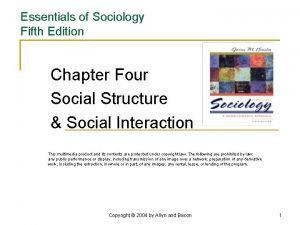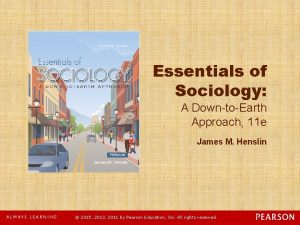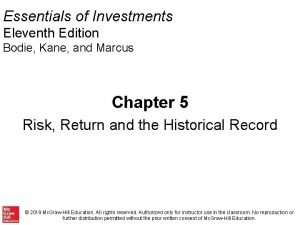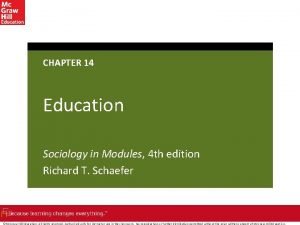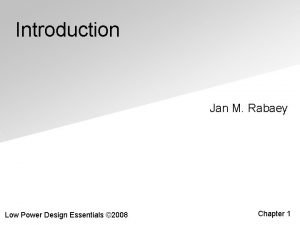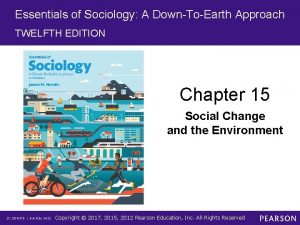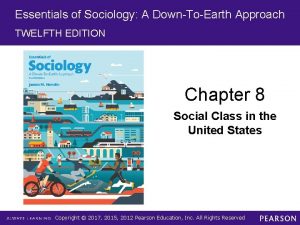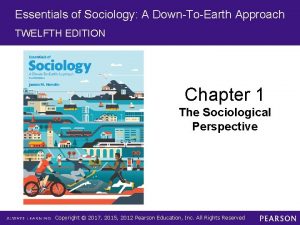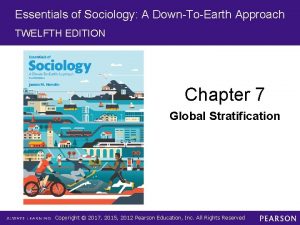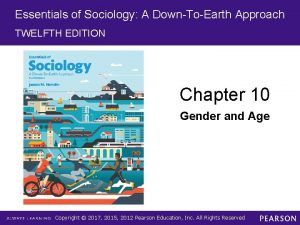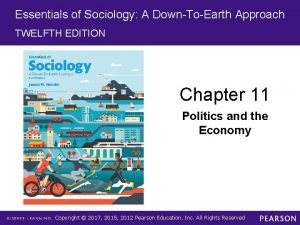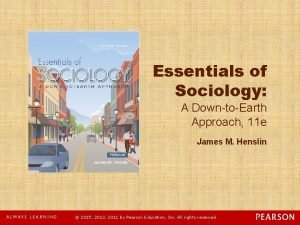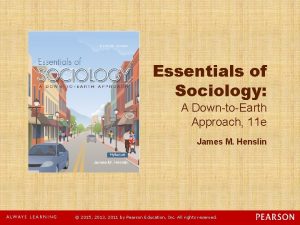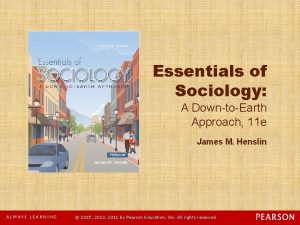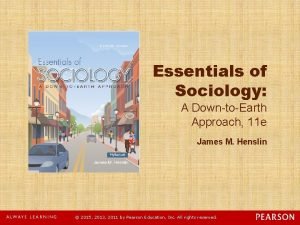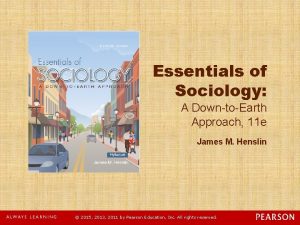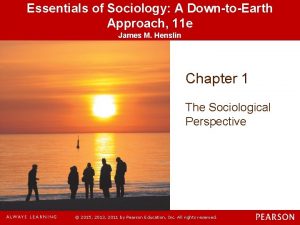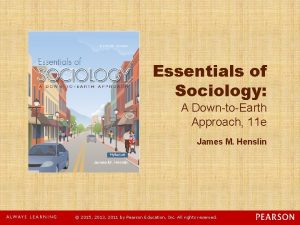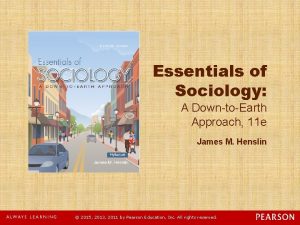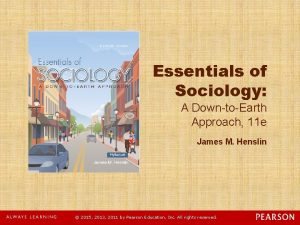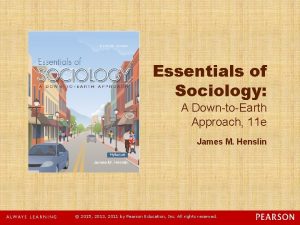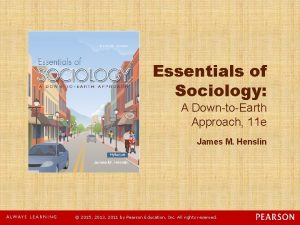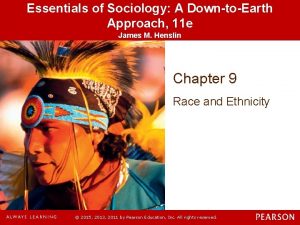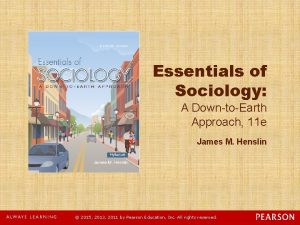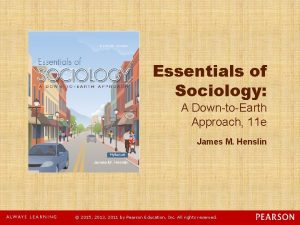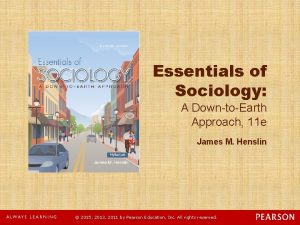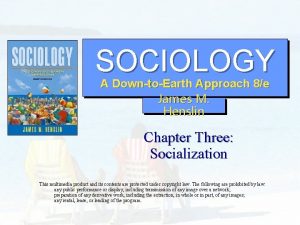Essentials of Sociology A DownToEarth Approach TWELFTH EDITION



















































- Slides: 51

Essentials of Sociology: A Down-To-Earth Approach TWELFTH EDITION Chapter 14 Population and Urbanization Copyright © 2017, 2015, 2012 Pearson Education, Inc. All Rights Reserved

Learning Objectives (1 of 3) 14. 1 Contrast the views of the New Malthusians and Anti-Malthusians on population growth and the food supply; explain why people are starving 14. 2 Explain why the Least Industrialized Nations have so many children, consequences of rapid population growth, population pyramids, the three demographic variables, and problems in forecasting population growth Copyright © 2017, 2015, 2012 Pearson Education, Inc. All Rights Reserved

Learning Objectives (2 of 3) 14. 3 Summarize the development of cities, the process of urbanization, U. S. urban patterns, and the rural rebound 14. 4 Compare the models of urban growth 14. 5 Discuss alienation and community, types of people who live in the city, the norm of noninvolvement, and the diffusion of responsibility Copyright © 2017, 2015, 2012 Pearson Education, Inc. All Rights Reserved

Learning Objectives (3 of 3) 14. 6 Explain the effects of suburbanization, disinvestment, and deindustrialization, and the potential of urban revitalization Copyright © 2017, 2015, 2012 Pearson Education, Inc. All Rights Reserved

LO 14. 1 A Planet with No Space for Enjoying Life? (1 of 4) • The New Malthusians • The Anti-Malthusians • Who Is Correct? • Why Are People Starving? Copyright © 2017, 2015, 2012 Pearson Education, Inc. All Rights Reserved

LO 14. 1 A Planet with No Space for Enjoying Life? (2 of 4) Large families on U. S. farms used to be common. Children helped plant and harvest crops, take care of animals, and prepare food. As the country industrialized and urbanized, children became nonproducers, making them expensive to have around. Consequently, the size of families shrank as we entered Stage 3 of the demographic transition. The two adult sons in this 1890 s Minnesota farm family are likely from their father’s first wife who died. Copyright © 2017, 2015, 2012 Pearson Education, Inc. All Rights Reserved

Figure 14. 1 How Fast Is the World’s Population Growing? SOURCE: By the author. Based on Haub and Kaneda 2014. Copyright © 2017, 2015, 2012 Pearson Education, Inc. All Rights Reserved

Figure 14. 2 World Population Growth SOURCES: Modified from Piotrow 1973; Mc. Falls 2007; based on projections from Haub and Kaneda 2015. Copyright © 2017, 2015, 2012 Pearson Education, Inc. All Rights Reserved

Figure 14. 3 The Demographic Transition Note: The standard demographic transition is depicted by Stages 1– 3. Stage 4 has been suggested by some Anti-Malthusians. SOURCE: Standard presentation modified by the author to add Stage 4. Copyright © 2017, 2015, 2012 Pearson Education, Inc. All Rights Reserved

LO 14. 1 A Planet with No Space for Enjoying Life? (3 of 4) One of the rats in the research reported on Bio. Foods. Copyright © 2017, 2015, 2012 Pearson Education, Inc. All Rights Reserved

Figure 14. 4 How Much Food Does the World Produce per Person? Note: 2004– 2006 equals 100. Projections by the author. SOURCES: By the author. Based on Simon 1981; Statistical Abstract of the United States 2010: Table 1335; Food and Agriculture Organization of the United Nations 2013. Copyright © 2017, 2015, 2012 Pearson Education, Inc. All Rights Reserved

LO 14. 1 A Planet with No Space for Enjoying Life? (4 of 4) Photos of starving children, such as this child in Somalia, haunt Americans and other members of the Most Industrialized Nations. Many of us wonder why, when some are starving, we should live in the midst of such abundance, often overeating and even casually scraping excess food into the garbage. As in this photo I took in San Antonio, Texas, we even have eating contests to see who can eat the most food in the least time. Copyright © 2017, 2015, 2012 Pearson Education, Inc. All Rights Reserved

LO 14. 2 Population Growth (1 of 7) • Why the Least Industrialized Nations Have So Many Children • Consequences of Rapid Population Growth • Population Pyramids as a Tool for Understanding • The Three Demographic Variables • Problems in Forecasting Population Growth Copyright © 2017, 2015, 2012 Pearson Education, Inc. All Rights Reserved

Figure 14. 5 World Population Growth, 1750– 2150 SOURCES: “The World of the Child 6 Billion” 2000; Haub and Kaneda 2015. Copyright © 2017, 2015, 2012 Pearson Education, Inc. All Rights Reserved

Figure 14. 6 Why the Poor Need Children SOURCE: U. N. Fund for Population Activities. Copyright © 2017, 2015, 2012 Pearson Education, Inc. All Rights Reserved

Figure 14. 7 Three Population Pyramids SOURCE: Population Today, 26, 9, September 1998: 4, 5. Copyright © 2017, 2015, 2012 Pearson Education, Inc. All Rights Reserved

LO 14. 2 Population Growth (2 of 7) Table 14. 1 Extremes in Childbirth Where Do Women Give Birth to the Fewest Children? Country Number of Children Andorra 1. 1 Hong Kong 1. 1 Taiwan 1. 1 Macao 1. 2 Moldova 1. 2 Poland 1. 2 Portugal 1. 2 Singapore 1. 2 South Korea 1. 2 Greece 1. 3 Copyright © 2017, 2015, 2012 Pearson Education, Inc. All Rights Reserved

LO 14. 2 Population Growth (3 of 7) Table 14. 1 Extremes in Childbirth Where Do Women Give Birth to the Fewest Children? Country Number of Children Niger 7. 6 South Sudan 7. 0 Chad 6. 6 Congo, Dem. Republic 6. 6 Somalia 6. 6 Angola 6. 2 Central African Rep. 6. 2 Burundi 6. 1 Mali 6. 1 Zambia 6. 0 Note: Six European countries tie for tenth place of 1. 3: Bosnia-Herzegovina, Greece, Hungary, Romania, Slovakia, and Spain. Source: Haub and Kaneda 2015. Copyright © 2017, 2015, 2012 Pearson Education, Inc. All Rights Reserved

LO 14. 2 Population Growth (4 of 7) Table 14. 2 Country of Birth of Authorized U. S. Immigrants Asia 3, 785, 000 El Salvador 252, 000 South America 906, 000 China 663, 000 Haiti 214, 000 Colombia 251, 000 India 663, 000 Jamaica 181, 000 Peru 146, 000 Philippines 587, 000 Canada 168, 000 Brazil 124, 000 Vietnam 306, 000 Guatemala 161, 000 Ecuador 113, 000 Korea 222, 000 Europe 1, 264, 000 Pakistan 157, 000 Ukraine Iran 126, 000 Bangladesh Venezuela 85, 000 149, 000 Guyana 76, 000 United Kingdom 154, 000 Argentina 51, 000 107, 000 Russia 140, 000 Africa 860, 000 Taiwan 88, 000 Poland 117, 000 Nigeria 111, 000 Japan 76, 000 Bosnia and Herzegovina 89, 000 Ethiopia 110, 000 North America 3, 605, 000 Germany 78, 000 Egypt 73, 000 Mexico 1, 693, 000 Romania 54, 000 Somalia 64, 000 Albania 51, 000 Ghana 65, 000 Cuba 318, 000 Dominican Republic 329, 000 Note: Totals are for the top countries of origin for 2001– 2010. Source: By the author. Based on Statistical Abstract of the United States 2014: Table 53. The totals for China and India are not in error; they are the same. Copyright © 2017, 2015, 2012 Pearson Education, Inc. All Rights Reserved

Figure 14. 8 Countries of Origin of Unauthorized Immigrants to the United States SOURCE: Statistical Abstract of the United States 2014: Table 48. Copyright © 2017, 2015, 2012 Pearson Education, Inc. All Rights Reserved

LO 14. 2 Population Growth (5 of 7) This couple is sitting in the grand prize they won for participating in the Day of Conception and giving birth on Russia Day. Copyright © 2017, 2015, 2012 Pearson Education, Inc. All Rights Reserved

LO 14. 2 Population Growth (6 of 7) Chinese officials have become concerned about the lopsided gender ratio that their “one couple, one child” policy has produced. Their recent billboards continue to promote this policy, but by featuring a female child they are trying to reduce female infanticide. Copyright © 2017, 2015, 2012 Pearson Education, Inc. All Rights Reserved

Figure 14. 9 Population Projections of the United States NOTE: The projections are based on different assumptions of fertility, mortality, and especially migration. SOURCE: By the author. Based on Day 2010. Copyright © 2017, 2015, 2012 Pearson Education, Inc. All Rights Reserved

LO 14. 2 Population Growth (7 of 7) • Targeting female fetuses for abortion has become a main issue of the emerging feminist movement in India. Copyright © 2017, 2015, 2012 Pearson Education, Inc. All Rights Reserved

LO 14. 3 The Development of Cities (1 of 2) • The Process of Urbanization • U. S. Urban Patterns • The Rural Rebound Copyright © 2017, 2015, 2012 Pearson Education, Inc. All Rights Reserved

LO 14. 3 The Development of Cities (2 of 2) Early cities were small economic centers surrounded by walls to keep out enemies. These cities had to be fortresses, for they were constantly under threat. This photo is of Ávila, Spain, whose walls date from 1090. Copyright © 2017, 2015, 2012 Pearson Education, Inc. All Rights Reserved

Figure 14. 10 A Global Boom: Cities with over One Million Residents SOURCES: By the author. Based on Chandler and Fox 1974; Brockerhoff 2000; United Nations 2014: Figure 8. Copyright © 2017, 2015, 2012 Pearson Education, Inc. All Rights Reserved

Figure 14. 11 How the World Is Urbanizing SOURCE: By the author. Based on United Nations 2010. Copyright © 2017, 2015, 2012 Pearson Education, Inc. All Rights Reserved

Medellin, Colombia: A Walk Through El Tiro (1 of 12) Almost at the top of the garbage heap, I saw this boy in front of his house. His mother hung out the family’s wash to dry. Copyright © 2017, 2015, 2012 Pearson Education, Inc. All Rights Reserved

Medellin, Colombia: A Walk Through El Tiro (2 of 12) Kids are kids the world over. These children don’t know they are poor. They are having a great time playing on a pile of dirt in the street. Copyright © 2017, 2015, 2012 Pearson Education, Inc. All Rights Reserved

Medellin, Colombia: A Walk Through El Tiro (3 of 12) This is one of my favorite photos. The woman is happy that she has a home—and proud of what she has done with it. What I find remarkable is the flower garden she so carefully tends, and has taken great effort to protect from children and dogs. I can see the care she would take of a little suburban home. Copyright © 2017, 2015, 2012 Pearson Education, Inc. All Rights Reserved

Medellin, Colombia: A Walk Through El Tiro (4 of 12) This is the “richer” area below El Tiro. As you can see, some of the residents own cars. Copyright © 2017, 2015, 2012 Pearson Education, Inc. All Rights Reserved

Medellin, Colombia: A Walk Through El Tiro (5 of 12) The road to El Tiro. On the left, going up the hill, is a board walk. To the right is a meat market (carnicería). Note the structure above the meat market, where the family that runs the store lives. Copyright © 2017, 2015, 2012 Pearson Education, Inc. All Rights Reserved

Medellin, Colombia: A Walk Through El Tiro (6 of 12) El Tiro has home delivery. Copyright © 2017, 2015, 2012 Pearson Education, Inc. All Rights Reserved

Medellin, Colombia: A Walk Through El Tiro (7 of 12) It doesn’t take much skill to build your own house in El Tiro. A hammer and saw, some nails, and used lumber will provide most of what you need. This man is building his house on top of another house. Copyright © 2017, 2015, 2012 Pearson Education, Inc. All Rights Reserved

Medellin, Colombia: A Walk Through El Tiro (8 of 12) An infrastructure has developed to serve El Tiro. This woman is waiting in line to use the only public telephone. Copyright © 2017, 2015, 2012 Pearson Education, Inc. All Rights Reserved

Medellin, Colombia: A Walk Through El Tiro (9 of 12) “What does an El Tiro home look like inside? ” I kept wondering. Then Jaro, my guide (on the left), took me inside the home of one of his parishioners. Amelia keeps a neat house, with everything highly organized. Copyright © 2017, 2015, 2012 Pearson Education, Inc. All Rights Reserved

Medellin, Colombia: A Walk Through El Tiro (10 of 12) What do people do to make a living in El Tiro? Anything they can. This man is sharpening a saw in front of his home. Copyright © 2017, 2015, 2012 Pearson Education, Inc. All Rights Reserved

Figure 14. 12 The World’s 10 Largest Megacities SOURCE: By the author. Based on United Nations 2014. Copyright © 2017, 2015, 2012 Pearson Education, Inc. All Rights Reserved

Figure 14. 13 How Urban Is Your State? The Rural–Urban Makeup of the United States SOURCE: By the author. Based on Statistical Abstract of the United States 2014: Table 30. Copyright © 2017, 2015, 2012 Pearson Education, Inc. All Rights Reserved

Medellin, Colombia: A Walk Through El Tiro (11 of 12) Table 14. 3 The Shrinking and the Fastest-Growing Cities The Shrinking Cities The Fastest-Growing Cities 1. – 8. 0% New Orleans, LA 1. +51. 3% Las Vegas, NV 2. – 7. 5% Youngstown, OH 2. +46. 9% Raleigh, NC 3. – 4. 1% Flint, MI 3. +44. 6% Cape Coral–Ft. Myers, FL 4. – 4. 0% Cleveland, OH 4. +44. 4% Provo, UT 5. – 3. 6% Detroit, MI 5. +44. 3% Myrtle Beach, SC 6. – 3. 1% Buffalo–Niagara Falls, NY 6. +44. 2% Austin, TX 7. – 2. 9% Pittsburgh, PA 7. +44. 0% Greeley, CO 8. – 1. 3% Toledo, OH 8. +40. 2% Mc. Allen, TX 9. – 0. 8% Canton, OH 9. +38. 0% Kennewick, WA 10. – 0. 6% Utica-Rome, NY 10. +37. 6% Fayetteville, AR Note: Population change from 2000 to 2012, the latest years available. Source: By the author. Based on Statistical Abstract of the United States 2014: Table 21. Copyright © 2017, 2015, 2012 Pearson Education, Inc. All Rights Reserved

Medellin, Colombia: A Walk Through El Tiro (12 of 12) One indication of the remarkable transformation of Harlem is town hall meetings. This one was held to discuss a rezoning issue. Copyright © 2017, 2015, 2012 Pearson Education, Inc. All Rights Reserved

LO 14. 4 Models of Urban Growth • The Concentric Zone Model • The Sector Model • The Multiple-Nuclei Model • The Peripheral Model • Critique of the Models Copyright © 2017, 2015, 2012 Pearson Education, Inc. All Rights Reserved

Figure 14. 14 How Cities Develop: Models of Urban Growth SOURCE: Cousins and Nagpaul 1970; Harris 1997. Copyright © 2017, 2015, 2012 Pearson Education, Inc. All Rights Reserved

LO 14. 5 City Life (1 of 3) • Alienation in the City • Community in the City • Who Lives in the City? • The Norm of Noninvolvement and the Diffusion of Responsibility Copyright © 2017, 2015, 2012 Pearson Education, Inc. All Rights Reserved

LO 14. 5 City Life (2 of 3) It is difficult for Americans to grasp the depth of the poverty that is the everyday life of hundreds of millions of people across the globe. This man in Cambodia lives in this unused concrete drain pipe. Copyright © 2017, 2015, 2012 Pearson Education, Inc. All Rights Reserved

LO 14. 5 City Life (3 of 3) Where do you think these people fit in Gans’ classification of urban dwellers? Copyright © 2017, 2015, 2012 Pearson Education, Inc. All Rights Reserved

LO 14. 6 Urban Problems and Social Policy (1 of 3) • Suburbanization • Disinvestment and Deindustrialization • The Potential of Urban Revitalization Copyright © 2017, 2015, 2012 Pearson Education, Inc. All Rights Reserved

LO 14. 6 Urban Problems and Social Policy (2 of 3) As cities evolve, so does architecture. This photo is of the Exhibition and Conference Center in Glasgow, Scotland. Copyright © 2017, 2015, 2012 Pearson Education, Inc. All Rights Reserved

Figure 14. 15 Urban Growth and Urban Flight Copyright © 2017, 2015, 2012 Pearson Education, Inc. All Rights Reserved

LO 14. 6 Urban Problems and Social Policy (3 of 3) U. S. suburbs were once unplanned, rambling affairs that took irregular shapes as people moved away from the city. Today’s suburbs are planned to precise details even before the first foundation is laid. This photo is of a suburb in Maryland. Copyright © 2017, 2015, 2012 Pearson Education, Inc. All Rights Reserved
 Essentials of sociology 5th edition
Essentials of sociology 5th edition Essentials of sociology: a down-to-earth approach
Essentials of sociology: a down-to-earth approach Management twelfth edition
Management twelfth edition Nonintervention perspective of criminal justice
Nonintervention perspective of criminal justice Business essentials 12th edition answer key
Business essentials 12th edition answer key Types of group
Types of group William stallings network security essentials 5th edition
William stallings network security essentials 5th edition Firefighter essentials 7th edition
Firefighter essentials 7th edition At a bulk transport incident, firefighters must:
At a bulk transport incident, firefighters must: Business essentials 12th edition chapter 1
Business essentials 12th edition chapter 1 Business essentials 12th edition
Business essentials 12th edition Cryptographic systems are generically classified by
Cryptographic systems are generically classified by Essentials of investments 11th edition
Essentials of investments 11th edition Essentials of mis, 13th edition
Essentials of mis, 13th edition Sociology in modules 4th edition
Sociology in modules 4th edition Introduction to sociology 9th edition
Introduction to sociology 9th edition Sociology 16th edition
Sociology 16th edition Mis
Mis Mis chapter 6
Mis chapter 6 I will drop in his way some obscure epistles of love
I will drop in his way some obscure epistles of love Ironic and humorous plays
Ironic and humorous plays I am not what i am twelfth night
I am not what i am twelfth night Satire in twelfth night
Satire in twelfth night Duke orsino character analysis
Duke orsino character analysis Twelfth night characters
Twelfth night characters Themes in twelfth night
Themes in twelfth night Twelfth night speeches
Twelfth night speeches Deverell twelfth night
Deverell twelfth night Blogspot
Blogspot Language
Language Jenny phelps
Jenny phelps Twelfth night ppt
Twelfth night ppt I disappeared on the night before my twelfth birthday
I disappeared on the night before my twelfth birthday Twelfth night act 1 scene 5 summary
Twelfth night act 1 scene 5 summary Twelfth night act 5
Twelfth night act 5 Msik
Msik Computer architecture a quantitative approach sixth edition
Computer architecture a quantitative approach sixth edition Computer architecture 5th edition
Computer architecture 5th edition Fifth edition chemistry a molecular approach
Fifth edition chemistry a molecular approach Computer architecture a quantitative approach sixth edition
Computer architecture a quantitative approach sixth edition Computer architecture a quantitative approach sixth edition
Computer architecture a quantitative approach sixth edition Child development: an active learning approach 4th edition
Child development: an active learning approach 4th edition Explain virtual circuit and datagram network
Explain virtual circuit and datagram network Multiple approach avoidance
Multiple approach avoidance Tony wagner's seven survival skills
Tony wagner's seven survival skills Theoretical models of counseling
Theoretical models of counseling Cognitive approach vs behavioral approach
Cognitive approach vs behavioral approach Research approaches definition
Research approaches definition Shower approach in international marketing
Shower approach in international marketing Traditional approach to systems implementation
Traditional approach to systems implementation Essentials of strength training and conditioning
Essentials of strength training and conditioning Low power design essentials
Low power design essentials
